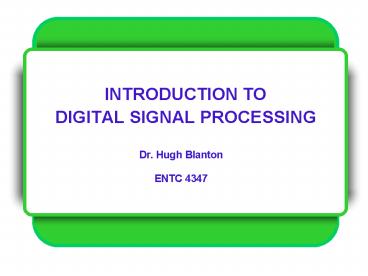INTRODUCTION TO DIGITAL SIGNAL PROCESSING - PowerPoint PPT Presentation
Title:
INTRODUCTION TO DIGITAL SIGNAL PROCESSING
Description:
A/D & signal processors speed: wide-band signals still difficult to treat ... Digital audio Stereo and surround sound Audio equalization and mixing Electronic ... – PowerPoint PPT presentation
Number of Views:59
Avg rating:3.0/5.0
Title: INTRODUCTION TO DIGITAL SIGNAL PROCESSING
1
INTRODUCTION TODIGITAL SIGNAL PROCESSING
- Dr. Hugh Blanton
- ENTC 4347
2
TOPICS
- Impact of DSP
- Analog vs. digital why, what how
- Digital system example
- Sampling aliasing
- ADCs performance choice
- Digital data formats
3
Digital vs Analog
Digital Signal Processing
4
Impact of DSP on Modern Living
Cellular/mobile telephony Speech and channel
coding Voice and data processing Power
management Multipath equaliztion
Digital audio Stereo and surround
sound Audio equalization and mixing
Electronic music
Medical electronics Critical/intensive care
monitors Digital X-rays
ECG analyzers
Cardiac monitors
Medical imaging
Automotive Digital Audio
Digital Radio
Personal communication systems
Active suspension
Personal computer Sound cards
Data storage and retrieval Error
correction/concealment Multimedia
Modems
5
Analog digital signals
6
DSP aim tools
7
Digital system example
8
Digital system implementation
KEY DECISION POINTS Analysis bandwidth, Dynamic
range
Pass / stop bands.
- Sampling rate.
No. of bits. Parameters.
9
Sampling
How fast must we sample a continuous signal to
preserve its info content?
Why?
Frequency misidentification due to low sampling
frequency.
10
Sampling - 2
11
The sampling theorem
A signal s(t) with maximum frequency fMAX can be
recovered if sampled at frequency fS gt 2 fMAX .
Theo
Multiple proposers Whittaker(s), Nyquist,
Shannon, Kotelnikov.
Naming gets confusing !
Nyquist frequency (rate) fN 2 fMAX or fMAX or
fS,MIN or fS,MIN/2
12
Frequency domain (hints)
- Time frequency two complementary signal
descriptions. Signals seen as projected onto
time or frequency domains.
Warning formal description makes use of
negative frequencies !
13
Sampling low-pass signals
14
Antialiasing filter
15
Under-sampling (hints)
Using spectral replications to reduce sampling
frequency fS reqments.
16
Over-sampling (hints)































